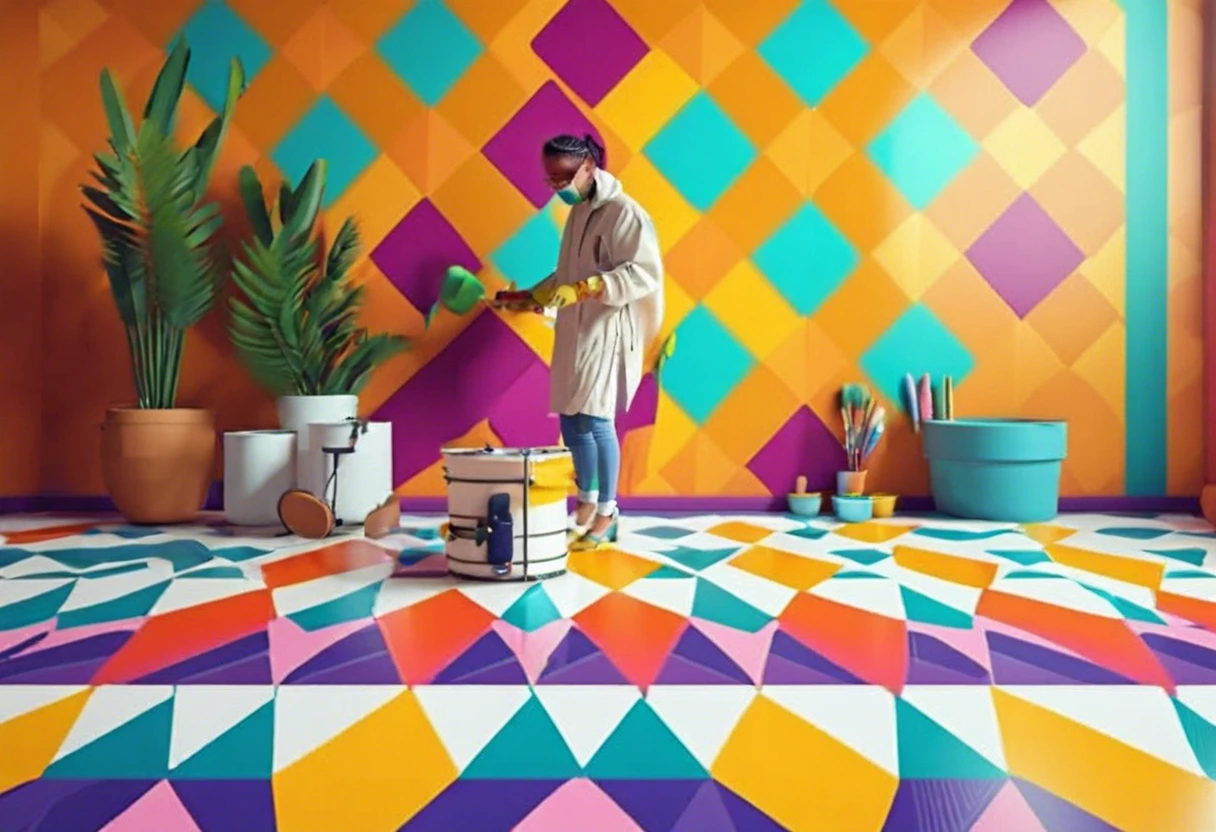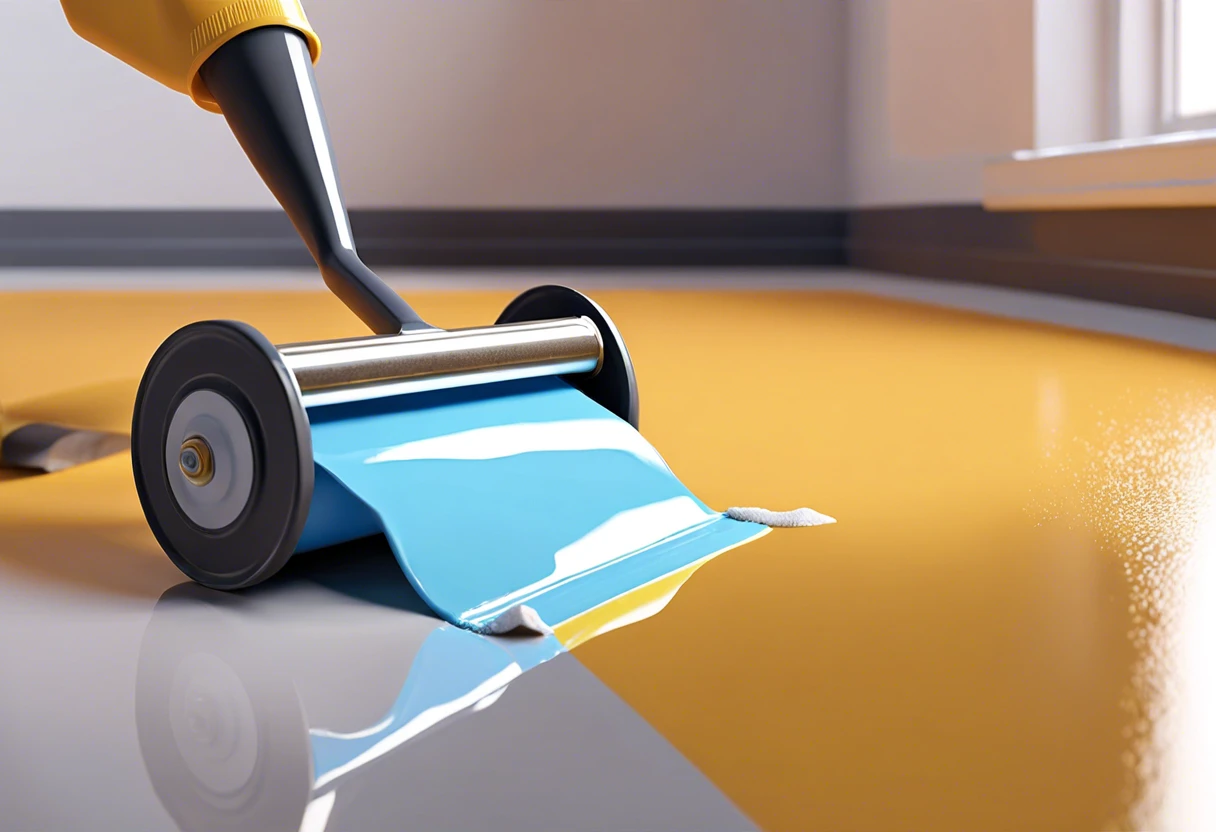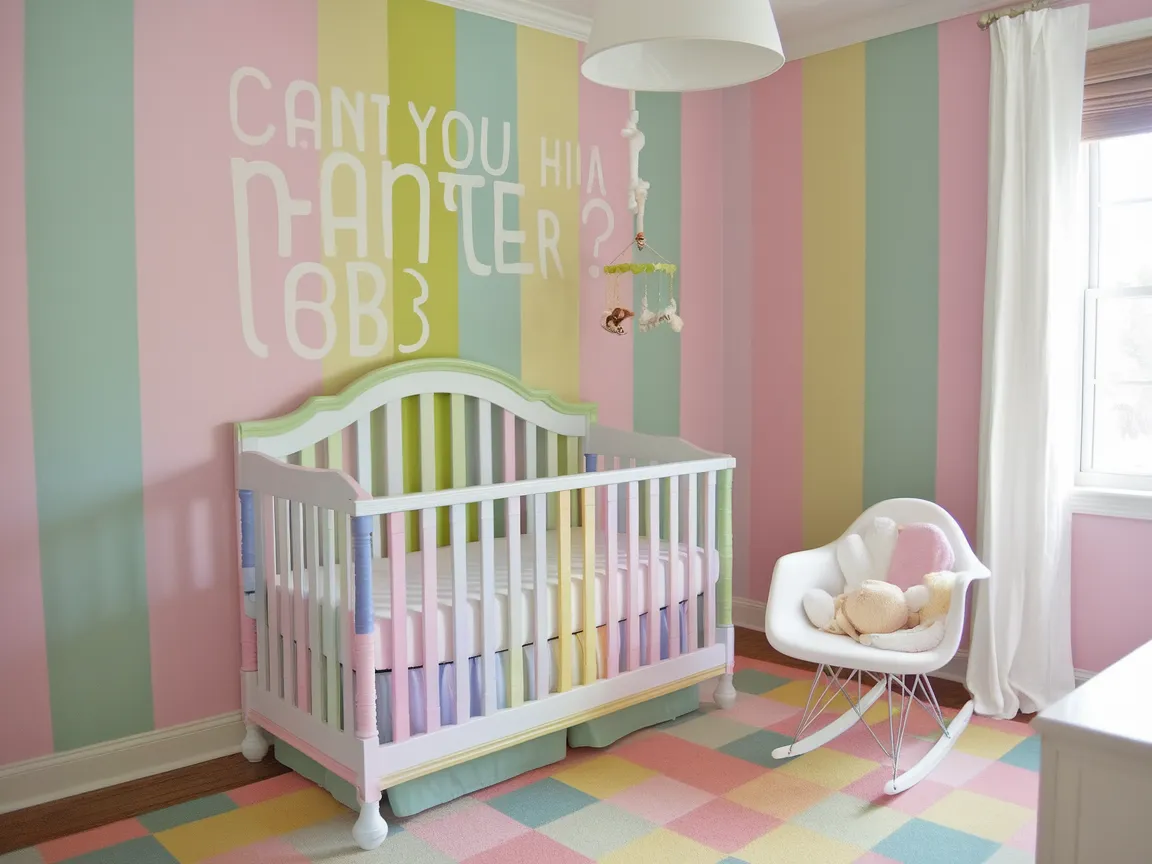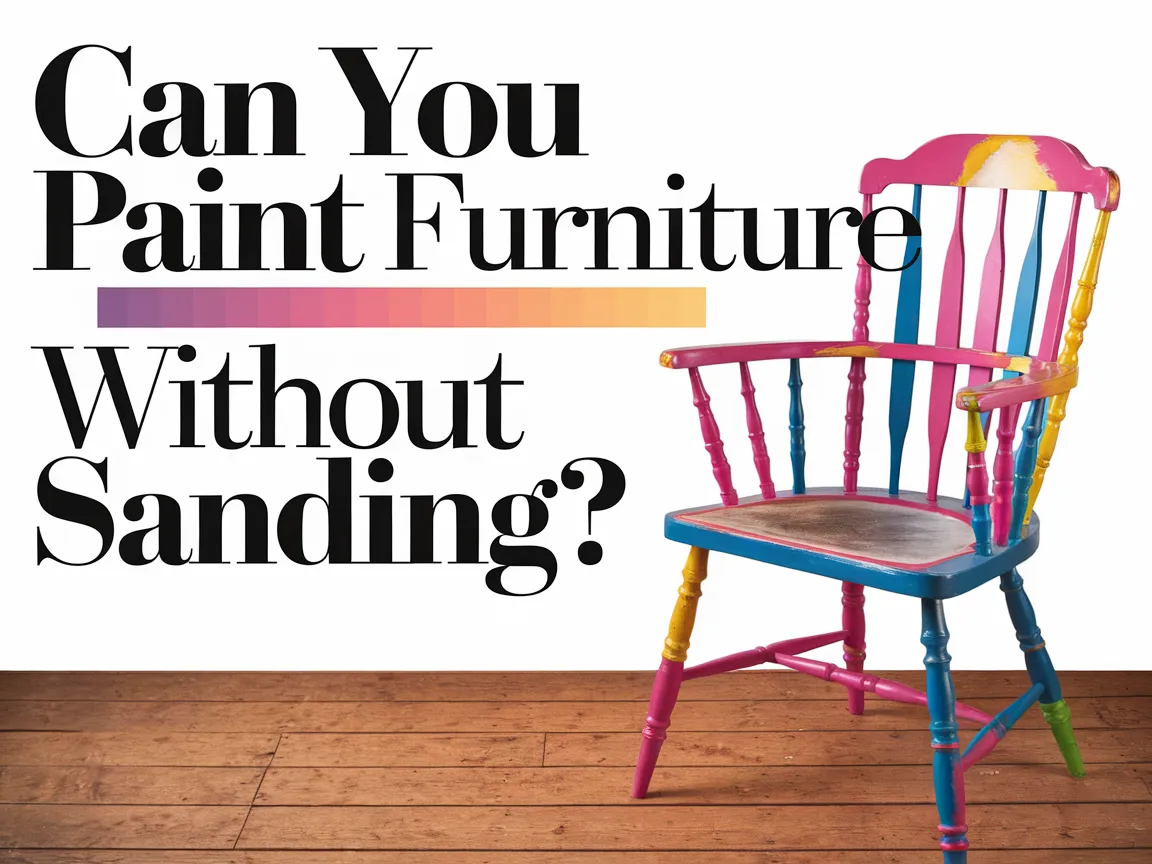Can You Paint Vinyl Floor?
Vinyl floor is a kind of soft, flexible material that feels nice under your feet. It’s like a colorful blanket for your floors, making them look pretty and easy to clean!
So, can you paint vinyl floor surfaces? It’s super important to know the right steps and materials to use. I once tried painting vinyl flooring without proper prep, and let’s say, it didn’t turn out too pretty.
In this guide, we’ll explore what vinyl flooring is, things to think about before painting, step-by-step instructions, best color choices, types that can handle paint, factors for success, common problems, finishing touches, and some cool DIY ideas. You’ll learn how to paint vinyl flooring like a pro!
Contents
- 1 Can You Paint Vinyl Floor?
- 2 What is Vinyl Flooring?
- 3 What to Consider Before You Start Painting Vinyl Floors
- 4 Steps to Successfully Paint Vinyl Flooring
- 5 Types Of Vinyl Flooring That Can Be Painted
- 6 Factors Affecting the Success Of Painting Vinyl Floors
- 7 Common Issues to Watch Out for When Painting Vinyl Floors
- 8 Finishing Touches to Enhance Your Painted Vinyl Floors
- 9 Maintenance Tips for Painted Vinyl Floors
- 10 Cost Analysis: Is Painting Vinyl Flooring Budget-Friendly?
- 11 Creative DIY Project Ideas for Customizing Your Vinyl Floors
- 12 Frequently Asked Questions About Painting Vinyl Floors
- 13 Conclusion
- 14 Additional Resources
Can You Paint Vinyl Floor?
Yes, you can paint a vinyl floor! Use a special vinyl paint for durability. Prep the surface by cleaning it well and priming if needed. Follow the instructions for the best results.
The Finishing Touch
A freshly painted wall is a blank canvas. The best way to bring your room to life is with a single piece of statement art that ties everything together.
Browse Wall Art at Big Wall DecorWhat is Vinyl Flooring?
Vinyl flooring is a synthetic material made from polyvinyl chloride (PVC). It’s flexible, durable, and comes in sheets, tiles, or planks, with thicknesses typically ranging from 1.5 mm to 5 mm (0.06 Inches to 0.2 Inches).
Can you paint vinyl floors? I remember my first time experimenting with painting vinyl surfaces. I felt both excited and nervous, wondering if my idea would last.
For work, vinyl flooring helped me with my kitchen renovation. It taught me about durability, maintenance, and versatility. When I looked into painting vinyl flooring, I was intrigued by the creative options available. Many people love transforming their spaces with bold colors or designs, using techniques like stenciling to enhance their appearance.
What to Consider Before You Start Painting Vinyl Floors
What do you need to get started?
- Vinyl Floor Primer: Use a reliable primer, like Zinsser 1-2-3, for proper adhesion. It helps the paint stick.
- Specialty Vinyl Paint: Select paint specifically designed for vinyl, such as Rust-Oleum Painter’s Touch in Satin finish. It ensures durability and longevity.
- Foam Roller: A 10-inch foam roller provides even coverage without streaks and allows for smooth, quick application.
- Painter’s Tape: High-quality tape, like FrogTape, is essential for clean edges. It prevents paint from seeping into unwanted areas.
- Floor Scraper: A durable floor scraper, like the Roberts 10-45, helps remove old finishes or adhesives, giving you a clean slate for painting.
We covered key factors to consider before painting vinyl floors. We will now cover the steps to successfully paint vinyl flooring.
Also See: Can Furniture Be Spray Painted? Refresh Your Space!

Steps to Successfully Paint Vinyl Flooring
Here are the steps to transform your space by painting vinyl flooring.
-
Prepare the Vinyl Surface
Start by cleaning the vinyl floor thoroughly. Use a mixture of warm water and mild detergent—like 1 liter of water to 50 mL of detergent.
Rinse the floor with clean water and let it dry for 24 hours. Any soap or grime leftover will lead to poor paint adhesion.
-
Apply Primer
Next, choose the right primer. Use an enamel primer designed for vinyl surfaces for the best results; this is crucial for paint longevity.
Apply the primer evenly with a roller. Wait until it’s fully dry—this usually takes about 6 hours at room temperature (20°C to 25°C or 68°F to 77°F)—before applying paint.
-
Painting the Vinyl Floor
Now it’s time to paint! Use high-quality vinyl floor paint to ensure durability. Generally, three coats are ideal for solid coverage.
Apply the first coat using a roller and a paintbrush for the edges. Wait about 2-4 hours between coats, but check the specific paint instructions for exact times.
-
Sealing the Painted Floor
After the final coat dries, sealing is essential. Use a water-based polyurethane sealant—this provides UV protection, ensuring your colors won’t fade over time.
Finish with 2-3 coats for durability, waiting 4-6 hours between each. Always let the floor cure for at least 48 hours before heavy foot traffic to achieve a robust finish.
You should now have a good understanding of how to effectively paint vinyl floors. In the next part, we’ll discuss types of vinyl flooring suitable for painting.
The Finishing Touch
A freshly painted wall is a blank canvas. The best way to bring your room to life is with a single piece of statement art that ties everything together.
Browse Wall Art at Big Wall DecorTypes Of Vinyl Flooring That Can Be Painted
Let’s explore the types of vinyl flooring you can paint: sheet vinyl, vinyl tiles, vinyl plank flooring, and luxury vinyl tiles.
-
Sheet Vinyl
Sheet vinyl typically comes in wide rolls, covering a large area with few seams. Use quality paint designed for vinyl to avoid peeling.
-
Vinyl Tiles
This type features individual tiles that are easily replaceable. You can paint vinyl tiles successfully, but surface preparation and paint choice are crucial for durability.
-
Vinyl Plank Flooring
Vinyl plank flooring mimics wood and can be painted with the right primer and paint. Choose products with excellent adhesion to vinyl for the best results.
-
Luxury Vinyl Tiles (LVT)
LVT offers a premium look and feel. It’s essential to use paint formulated for PVC to ensure it withstands foot traffic and spills.
In my experience, one thing stands out about vinyl plank flooring: a fresh coat of paint can revitalize a room and add personality without breaking the bank.
So far we covered the different kinds of vinyl flooring suitable for painting. Let’s look at the factors influencing successful paint application.
Factors Affecting the Success Of Painting Vinyl Floors
What factors determine the quality of a painted vinyl surface?
-
Surface Preparation: Cleaning and priming create a solid base for paint adhesion.
-
Type of Paint: Using acrylic or spray paint made for vinyl ensures better results and flexibility.
-
Humidity and Temperature: Ideal conditions, typically 60-75°F (15-24°C), help paint cure evenly.
-
Vinyl Condition: Damage or wear can prevent paint from sticking, leading to peeling or chipping.
We have now covered the elements influencing the effectiveness of painting vinyl floors. Next, we will discuss frequent challenges to be aware of.

Common Issues to Watch Out for When Painting Vinyl Floors
My friend tried to paint her vinyl floor, but it started bubbling after just a week. The paint didn’t adhere well because she skipped proper preparation.
To fix this, lightly sand the floor (220 Grit), clean it with a degreaser, and then apply an oil-based primer. Use acrylic paint designed for vinyl to finish the job correctly.
Finishing Touches to Enhance Your Painted Vinyl Floors
After painting your vinyl, apply a high-quality polyurethane sealer—choose one with a 25% solids content for extra durability. Wait 48 hours before walking on it or placing furniture.
Inspect your painted vinyl floor weekly for bubbles or scratches. Use a product like Goo Gone Vinyl cling wrap to quickly flatten or patch areas smaller than 5 mm (0.2 In).
Here’s a pro tip: to maintain the finish, reapply sealer every six months with a 4-inch (10.16 Cm) foam roller. It’ll keep your painted vinyl looking vibrant.
Maintenance Tips for Painted Vinyl Floors
Keeping your painted vinyl floors looking fresh requires some ongoing care. Here are key maintenance tips to consider.
-
Regular Cleaning
Use a gentle, pH-neutral cleaner. A solution of 1:10 vinegar to water works wonders, keeping colors bright without harsh chemicals.
-
Quick Repairs
For small scratches, touch up with leftover paint and a fine brush. This keeps your floor looking neat and tidy.
-
Avoid Moisture
Excess moisture can damage painted surfaces. If spills happen, blot them immediately and avoid soaking the area.
-
Use Rugs
Place rugs in high-traffic areas. They not only protect the finish but add a decorative touch to your space.
The Finishing Touch
A freshly painted wall is a blank canvas. The best way to bring your room to life is with a single piece of statement art that ties everything together.
Browse Wall Art at Big Wall DecorCost Analysis: Is Painting Vinyl Flooring Budget-Friendly?
Wondering if painting vinyl flooring fits your budget? Let’s break down the costs involved.
| Item | Estimated Cost (USD) | Notes |
|---|---|---|
| Vinyl Floor Paint (1 gallon) | $25 – $50 | Covers about 350 – 400 sq. ft. (32.5 – 37 m²) |
| Primer (1 gallon) | $15 – $30 | Covers about 300 – 400 sq. ft. (27.9 – 37 m²) |
| Tools & Supplies (roller, brush, tape) | $20 – $40 | Includes one-time purchase of necessary tools. |
| Total Estimated Cost for Painting | $60 – $120 | Depending on the area size and quality of materials. |
Creative DIY Project Ideas for Customizing Your Vinyl Floors
Wanna spruce up your space? How about creating a stunning vinyl floor mural or even a geometric pattern that screams YOU!
For the mural, all you need is vinyl-safe paint and stencils; expect to spend about $50-75 and a weekend transforming a drab floor. A geometric pattern is super simple—just tape and paint, likely under $30 and a day’s work, and boom, style overload! If you have ever wondered about the costs behind professional paint, you might be curious why interior painting techniques can vary in complexity and cost. Explore in detail why automotive paint can be so expensive.
Now, you might wonder, can you paint vinyl floor? Absolutely! If I’d paint my vinyl flooring, I’d consider decoupage with fun fabric swatches or use removable adhesive wallpaper for a wild twist and instant lift. Trust me, it’s bold and surprisingly chic!
Another way to add character to your home is by antiquing your furniture with paint and stain, which can beautifully complement your flooring design. Discover simple techniques for antiquing furniture with paint and stain.
Frequently Asked Questions About Painting Vinyl Floors
Can All Types Of Vinyl Flooring Be Painted Successfully?
Yes, not all types of vinyl flooring can be painted successfully. Smooth surfaces typically accept paint better than textured ones, and some finishes may repel paint. For painting to last, choose high-quality, durable vinyl floors designed for coatings.
What Kind Of Paint is Best for Vinyl Flooring?
The best kind of paint for vinyl flooring is specially formulated vinyl floor paint. These paints are designed to bond well, resist scuffs, and stand up to various foot traffic. Use oil-based or specific PVC paints for optimal results. You can also consider using acrylic paint on walls for certain aesthetic projects.
How Long Does Painted Vinyl Flooring Last?
Painted vinyl flooring can last anywhere from 3 to 5 years, depending on the quality of the paint and the wear and tear it experiences. Proper preparation and sealing can extend the lifespan, but high-traffic areas may see quicker signs of wear. In some situations, you might wonder whether a certain cleaning agent could help resolve defects in the finish, so you may consider if bleach could effectively remove paint.
Can I Use Regular Floor Cleaner on Painted Vinyl Floors?
No, you shouldn’t use regular floor cleaner on painted vinyl floors. Regular cleaners may contain harsh chemicals that can strip paint or dull the finish. Instead, opt for pH-neutral cleaners designed specifically for painted surfaces. If you’re venturing into creative projects, you might wonder if you can paint air-dry clay effectively, which requires similar careful consideration of materials.
Is It Worth Painting Vinyl Flooring?
Yes, painting vinyl flooring can be worth it if you’re looking for an affordable way to refresh a space. A good paint job can save you money compared to replacement, offering new aesthetics without breaking the bank. If you’re considering different applications of acrylic paint, you might want to explore using acrylic paint on skin.
How Much Does It Cost to Paint Vinyl Flooring?
Painting vinyl flooring typically costs between $1 to $3 per square foot (0.0929 To 0.2787 Square Meters). This includes paint and supplies. It’s a cost-effective solution compared to full replacement, which can run upwards of $5 to $7 per square foot.
Exploring unique techniques in art can be just as rewarding as finding affordable solutions for your home. If you’re intrigued by creative artistry, you might be interested in discovering who painted gravity-defying stairs.
How Do You Prepare Vinyl for Painting?
To prepare vinyl for painting, clean it thoroughly, sand the surface lightly, and apply a primer first. Removing dirt and grime ensures better adhesion, while priming helps the paint stick, leading to a longer-lasting finish.
Can I Paint Over Old Vinyl Floor Paint?
Yes, you can paint over old vinyl floor paint, but surface preparation is vital for good results. Make sure to clean, scuff, and potentially strip old paint before applying the new coat. This process helps to avoid peeling and flaking. If you plan to store paint, it’s important to know that acrylic paint can freeze, which affects its quality.
Conclusion
I hope this was worth your while as we covered what vinyl flooring is, what you should consider before painting, essential steps for successfully painting, recommended colors, types of vinyl that can be painted, factors impacting success, common issues, finishing touches, and DIY ideas.
So, can you paint vinyl floor? Yes, with the right paint, preparation, and technique, you can transform your vinyl planks. If you’re curious about whether your specific flooring can be painted or need additional tips, feel free to reach out for more guidance.
If you found this information helpful, explore more resources and insights from Paint Answers.
Additional Resources
- Loomis, A. (2011). Figure Drawing for All It’s Worth. New York, NY: Titan Books.
- How to Paint Over Vinyl Floors | Modernize
- Luxury Vinyl Floors: Can They Be Painted?
- How to paint vinyl floors? | Give your room a fresh update. – YouTube
Isabella is a Filipino-American art writer and critic specializing in contemporary painting, blending her Filipino heritage with global art trends. She holds a BFA from California State University, Long Beach, and a Minor in Art History from the University of the Philippines. Isa has experience as a Gallery Assistant, Art Appraisal Specialist, and Social Media Creative for Art & Design.
Floor, Interior









